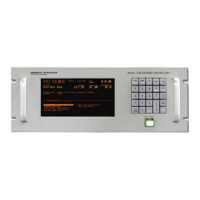Overview
2.4.2.1 AZ and EL Drive Inverters
One of the critical advantages of the 7200 ACS over many other systems is the
use of variable frequency drive inverters to control the speed of standard three-
phase induction motors for AZ and EL antenna motion. This approach has several
distinct advantages over the commonly used and simplistic on/off contactor control
of motor power. First, inverters allow General Dynamics to offer two-speed
control in a standard configuration without the problems associated with special
dual-wound motors or clumsy clutching arrangements. Secondly, the inverters
offer precision motor control by ramping motor speeds up and down in a controlled
manner rather than simply switching full motor power on and off and having to
contend with inertial coasting of the motor rotor and the related axis overshoot. In
addition to these two distinct advantages, the inverter drives offer superior motor
protection through sophisticated electronic motor overcurrent protection. Motor
current is continuously monitored and compared against allowable levels for
different conditions. Should the actual measured current exceed the allowable
levels, the inverter trips and the drive is disabled. The inverter then has the
capability to automatically reset and continue operation, provided the current
remains within allowable limits.
2.4.2.2 Polarization Motor Control (POL and 4th Axis)
A three-axis system uses a single-speed AC synchronous stepping motor for feed
assembly rotation (POL). In the four-axis system a pair of single-speed AC
synchronous stepping motors are used for feed assembly rotation. Both POL
motors are controlled and powered from the 7150 drive cabinet. Drive power to
the POL motor(s) is switched, according to the required direction of rotation, by
relays located on the Relay PCB. A resistance-capacitance (RC) network in the
drive cabinet provides the proper phase relationship to each motor.
2.4.2.3 Drive Cabinet Control Logic
Motor drive commands and interlock functions in the drive cabinet are performed
with relay logic operating at +24 VDC, which is derived from a regulated power
supply. Commands can be received from the ACU, or PMCU, for motor speed and
direction. The Drive Reset is controlled from the Relay PC board and the
Emergency Stop is located on the right side of the enclosure. The drive cabinet
relay logic then commands the axis drives accordingly. Likewise, limit switches
mounted on the structure activate relays in the drive cabinet upon engagement to
form axis interlocks and provide the appropriate fault reporting to the ACU.
2-19

